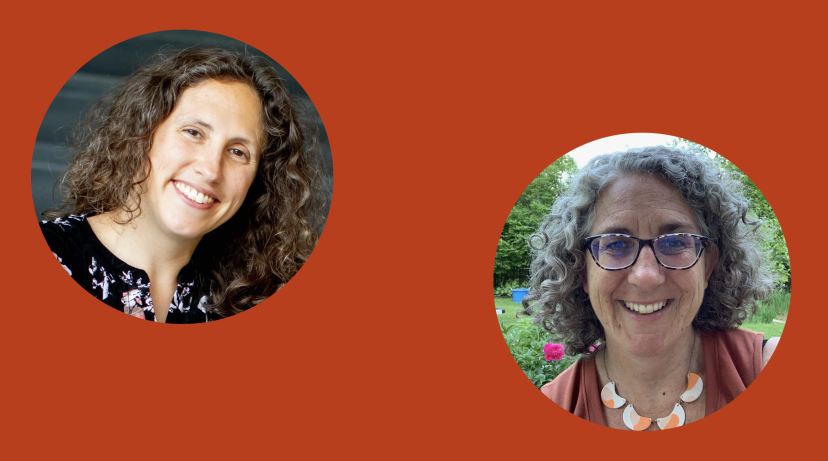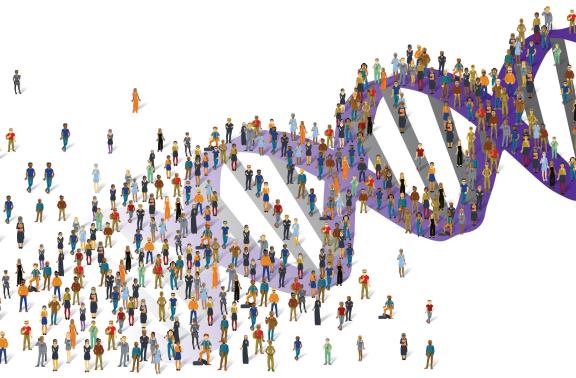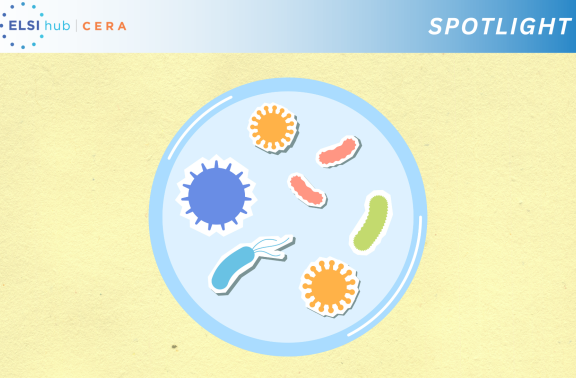
SNAPSHOTs: Expanding ELSI Education
Announcing the Personal Genetics Education Project (pgEd) / CERA Partnership
For over a decade, Marnie Gelbart, Ph.D., Director of Programs at the Personal Genetics Education Project (pgEd) in the Department of Genetics at Harvard Medical School, has promoted public discussion about genetic technologies by hosting Congressional briefings in Washington, D.C., working with faith communities, and collaborating with teachers and community groups. Dana Waring, M.L.A., pgEd Education Director and Co-Founder, uses her extensive experience and frequent interactions with teachers, students, and other community members to develop interdisciplinary curricula to increase awareness about the benefits and ethical, legal, and social implications of personal genetics. We are pleased to announce that Dr. Gelbart and Ms. Waring are collaborating with the CERA to expand the pgEd series of short, self-contained lessons called SNAPSHOTs. The partnership promises to both facilitate the dissemination of ELSI knowledge to general audiences and, by enhancing linkages between pgEd and the ELSI scholarly community, accelerate the incorporation of timely and relevant information into new pgEd resources.
SNAPSHOTs are “bite-sized” lessons informed by conversations with those who are impacted by genetic technologies and honed by feedback from teachers and students. Each is built around a central case study and explores key scientific concepts, potential benefits, and implications for individuals, families, and society. They are classroom-ready and intended for use by high school and college level educators to scaffold student-led explorations of genetic technologies and their use.
CERA staff spoke to Dr. Gelbart and Ms. Waring about the impetus for establishing pgEd, the important work of the organization, and the SNAPSHOT development process.
The Personal Genetics Education Project (pgEd) was founded 16 years ago. Could you please tell us about the history of the organization and its mission?
Dr. Gelbart: pgEd was established in the laboratory of Dr. Ting Wu, a Professor of Genetics at Harvard Medical School, in 2006, at a time when technological leaps were making it possible to think about sequencing the genomes of many individuals. Mindful of our field’s history of eugenics, Ting and her colleagues, Dana Waring and Jack Bateman, launched pgEd out of a belief that all-embracing and far-reaching education about the use of genomic technologies is essential for an equitable and safe path forward. Our mission is to increase awareness and conversation about genetics so that all people have the knowledge they want and need to guide their decisions, and so scientists’ work is responsive to input from the communities they serve. pgEd has grown over the years to operate on a larger scale, especially with the support of the Department of Genetics where we are housed, and yet, at our heart, we remain an organization that bridges divides, shares information, and listens to the hopes and concerns of a wide swath of people.
The pgEd team includes a unique combination of scientists, social scientists, educators, and community organizers. Could you tell us some of the typical ways that pgEd has engaged the public in thinking about genetic science? Has your work changed since the start of the COVID-19 pandemic?
Dr. Gelbart: We are an organization that seeks out people with experiences that are not typical of a genetics department within academia. As a result, we have been able to develop a curriculum and workshops that capture the complexity of issues at the intersection of genetics and society and invite in a host of personal morals, religious beliefs, cultural traditions, and community histories. Our team’s diverse work and life experiences have helped us to connect with anyone and everyone who wants to talk about genetics in their lives. This has brought us to all sorts of venues–visiting middle and high school classrooms, presenting at our local library, meeting with congregants and clergy in their place of worship, holding workshops at teacher conferences, and organizing Congressional briefings on Capitol Hill.
Like it did for many others, the pandemic brought us a lot of changes. Traditionally, our summers have been filled with travel. For example, in 2019, we did teacher workshops in 8 states. In 2020, we pivoted quickly to move these programs online. We’ve just started to do some events in person, but we are also holding on to some of the new opportunities we have found online.
What would you say has been your most important work?
Dr. Gelbart: We are most proud of our work in expanding the tent, both in terms of the wide range of topics we have incorporated into conversations about genetics and genetic technology, and our work to reach people who have been excluded from a seat at the table. We have only been able to do this because of the many people who have been kind enough to share their time and expertise with us. We have learned so much from each and every member of our team and from the people we have met in our travels. This has enabled us to infuse new ideas and perspectives into our work, make shifts in language choices, and offer materials that reflect the lived experiences of a wider range of people.
One example is work from a former staff member, Florcy Romero, who guided an effort to include discussions of the history of colonialism and land rights in curriculum on gene drives, de-extinction, and genome editing in agriculture. We have a collaboration going on right now that is revisiting a case study about the use of preimplantation genetic diagnosis to select for deafness, so that the final product is more affirming and reflective of the experiences of deaf people. Another project we’re hoping to get off the ground in the next year will co-create resources that provide a bridge for communities of faith to explore and discuss genetics and ELSI topics.
What excites you about the partnership between pgEd and the CERA?
Dr. Gelbart: Sixteen years into pgEd’s work, a scientific future that once seemed a distant horizon is now on our doorstep. Genomic technologies are moving outside the laboratory and into people’s lives at a stunning pace, and questions about how to use these tools are ensconced in some of the most complex and controversial issues of our time. The stakes are high – and the absence of public dialogue leaves us vulnerable. So it is a particularly good time to formalize a partnership with the ELSI researchers who have long been informing pgEd’s work on topics such as medical decision-making and informed consent, race and ancestry, noninvasive prenatal testing, and criminal justice.
We are excited to be working with the CERA team to develop and share resources that amplify discussions of ELSI topics in classrooms and the public sphere. The ELSIhub portal is a wonderful resource for us to find and connect with ELSI scholars as we develop new materials. We hope that ELSI researchers will find these teaching tools useful. Our door is open to anyone who would like to connect with us, especially those who share our mission to broaden the conversation beyond the halls of academia. So please reach out if you have an idea for a collaboration!
What motivated you to create SNAPSHOTs? Is there a need that they respond to?
Ms. Waring: An effort was already underway to split our larger lesson plans into smaller pieces so that they are more suited to classroom discussion or self-directed assignments. These efforts shifted into high gear at the start of the pandemic. Watching our own children’s teachers trying to adapt their hands-on learning experiences to remote lessons, we knew we could help meet this need. This effort dovetailed with a collaboration with WETA/PBS that paired lessons with clips from the documentary by Ken Burns, The Gene: An Intimate History. The video clips bring personal stories that fuel connection, which is something everyone needs and was particularly welcome in those early days of the pandemic. We have found that even as students and teachers return to the classroom, these bite-sized modules still fill a niche. For example, when educators have room in class for a narrow case study or are looking for a lesson that can be assigned for homework.
How are SNAPSHOTs created?
Ms. Waring: We start by asking ourselves a few questions:
1) What is one key concept we want students to walk away with?
2) Is there a question, idea, or issue that is not commonly included in textbooks that would be interesting for students to explore?
Our longer lessons, which we have been honing with students and teachers for years, are one source of inspiration. We also look at headlines, journal articles, documentaries, and books we are reading. SNAPSHOTS often tackle current topics and issues that are not yet (and might never!) make it into a textbook.
As topics bubble up, we make every effort to bring them to students and teachers. Even as we teach, we are in learning mode. We try out case studies to see what resonates and listen to what is on the minds of students and teachers to inform future work. From there, we look for companion videos or articles that we can build upon, and finally, we wrestle with getting the content level right. The comment history on our internal Google Docs tells a story about our careful attention to each word!
Could you share any stories from students or teachers about their experiences with these resources?
Ms. Waring: We’ve had positive feedback from teachers and students–especially about the ease of use and flexible fit into a classroom. Teachers have shared that these smaller pieces “make it possible to tackle some huge topics” and have reported that students respond to them in the classroom and online. We have been happy to hear that SNAPSHOTs travel outside the biology classroom into history, government, or health class!
Is there anything a teacher or student should know about how to use SNAPSHOTs?
Ms. Waring: We know teachers struggle to cover all the required topics each year. It is rare for topics to be removed from the curriculum, but new ones are always being added. Our SNAPSHOTs are designed with this in mind. They are largely self directed, and can fit into any number of spots in the standard biology curriculum–in lessons on genetics, ecology, or evolution to name a few places. Since they require little to no prep time, they can be used as supplements, homework, and ways to extend the lesson. With topics that are anticipated to be of great interest to students, we hope SNAPSHOTs will be a bridge for students to find connection between academic content and “the real world”.
What can we look forward to seeing in the next year of the pgEd/CERA partnership?
Ms. Waring: We are looking forward to continuing to create resources that meet needs in the classroom and help catalyze conversations that broaden students’ perspectives and challenge misconceptions. Our newest SNAPSHOTs about sickle cell trait may be of particular interest to ELSI researchers who are working to illuminate some of the most heated and complex issues at the intersection of genetics and society. We also are bringing some new voices and perspectives on disability, genetics, and medicine into our work. We will share some of the lessons learned from this co-creative process with the ELSI community, and also are excited to share our approach with our ELSI colleagues who are interested in broadening the conversation around genetics to new audiences.
CERA and pgEd are excited to provide educators with new tools that highlight ELSI perspectives on genetics for use in classrooms and beyond. SNAPSHOTs provide students with different perspectives as they shape their views on complex interactions between genomics and society. They include student materials (handouts, worksheets, and videos) and teacher guides with answer keys and links to longer lessons. Thirteen SNAPSHOTs are available on ELSIhub on rare genetic disorders and their treatment, the Genetic Information Non-Discrimination Act, genome editing, and other topics. SNAPSHOTs exploring sickle cell are currently under production and will be available in 2022. CERA is pleased to collaborate with individuals and organizations committed to enhancing the production, sharing, and use of ELSI scholarship. If you have an idea for collaboration, please email [email protected].


